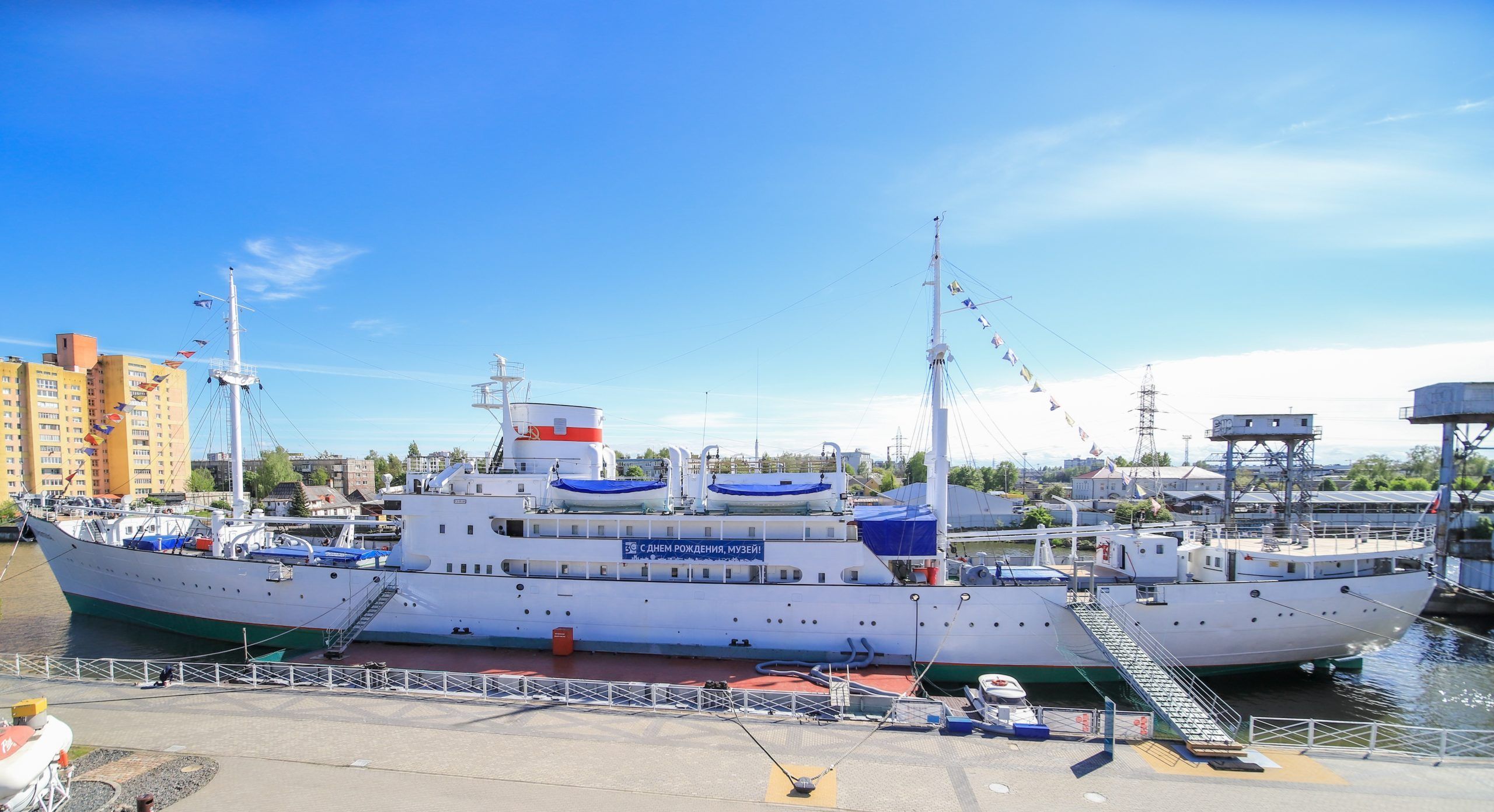Voices from the field
Larisa Zubina
From legendary vessels to museums
They used to measure the deepest point in the Mariana Trench, to prevent nuclear waste disposal in the oceans’ canyons, they described the deep-water fauna and carried millions of tons cargos… These are only some of the achievements accomplished by two great, historic ships – “Vityaz” and “Sołdek” – over the decades of service. Nowadays, the vessels are living their second lives as museum ships in Kaliningrad (Russia) and Gdansk (Poland). Thanks to the project “2 Ships – Common Sea” by Poland-Russia CBC programme, they are today able to tell their amazing stories to more visitors. Larisa Zubina, Deputy Director General of the Museum of the World Ocean (Lead beneficiary) is explaining how to preserve and promote such unique maritime legacy.
Soldek & Vityaz – why are these two ships unique? What is the story behind them?
The USSR joined the exploration of the World Ocean only after the World War II, catching up with countries such as Germany, the USA, Great Britain. The Institute of Oceanology of USSR Academy of Sciences was looking for a ship to carry out the studies. The choice was made for the vessel, allocated to the Soviet Union under the Potsdam Agreement, and renamed “Vityaz” in 1949. “Vityaz” is a legendary ship in the history of the oceanography. She measured the deepest point in the Mariana Trench reporting the unprecedented 11.022 meters, she described over 1000 new species of marine plants and animals, and detected the bottom flows which helped to prevent the disposal of the nuclear waste in the ocean canyons. “Sołdek” is also a unique ship if we talk about the Polish history. Being the first sea-going vessel put into operation in Poland after World War II, it contributed greatly to the economic struggle of the devastated country. Within 31 years of service, the vessel made 1479 voyages, carrying over 3,5 million tons of cargo and calling at more than 60 harbours. In the 1980s both ships were laid up permanently in the harbours of Kaliningrad and Gdansk. Nowadays, they present two amasing museums with captivating stories to narrate.
What are the main problems of the museum ships at the moment?
Of course, the maintenance. After its last 65th voyage “Vityaz” was brought to Kaliningrad’s Branch of the Institute of Oceanology, remaining abandoned for over 10 years. From the1990s, with the decision of opening a museum, the vessel underwent a complete reconstruction, and the exposition was organised. However, the maintenance of a museum ship is very expensive. Floating on water, the vessel wears out, corrodes and deteriorates. Our divers have to check the body and the bottom every year to monitor its conditions. Dry-docking is a must once in every five years: a thorough examination and replacement of materials make part of the repair works. They require big investments and considerable human resources.
What is the final aim of your project?
To preserve and protect the two historic museum ships and to create a new offer that will attract more visitors to both locations. We also want to boost the development of cross-border tourism between Poland and Russia, as well as with other Baltic states. By the end of the project, we hope to have two unique tourist products, and together with our Polish partner we are already planning an effective marketing strategy.
Which results have you achieved so far?
 In 2019 we completed the dock repair works and partially renovated deck’s premises. Some reconstruction will be also made inside of the ship. Our partners performed the dry-dock repairs too, replacing the steel plating of the hull, restoring the rusted rivets, and repainting the hull. We are proceeding with the reconstruction of the “Vityaz” deck space to accommodate the future exposition. The existing exposition, dedicated to the ship’s exploration of the World Ocean from 1949 till 1979, is going to be upgraded. We want to focus on the two important milestones from the “Vityaz epoch”: the exploration of deep-water zones of the world ocean and the international cooperation. On the other side of the border, the exposition ‘The Sołdek and her times’ will tell the story of Polish maritime technology, concentrating on the political, social, and economical context of ship’s construction and her years of service. Both ships will make the expositions available also for the people with disabilities.
In 2019 we completed the dock repair works and partially renovated deck’s premises. Some reconstruction will be also made inside of the ship. Our partners performed the dry-dock repairs too, replacing the steel plating of the hull, restoring the rusted rivets, and repainting the hull. We are proceeding with the reconstruction of the “Vityaz” deck space to accommodate the future exposition. The existing exposition, dedicated to the ship’s exploration of the World Ocean from 1949 till 1979, is going to be upgraded. We want to focus on the two important milestones from the “Vityaz epoch”: the exploration of deep-water zones of the world ocean and the international cooperation. On the other side of the border, the exposition ‘The Sołdek and her times’ will tell the story of Polish maritime technology, concentrating on the political, social, and economical context of ship’s construction and her years of service. Both ships will make the expositions available also for the people with disabilities.
Your project is organising art plein-airs: what are they aimed at?
It is important not only to preserve the ships but also to promote this precious historical heritage. We have initially planned to organise a cross-border exchange between Russian and Polish artists, each group painting marine cultural heritage sites and objects recalling to both ships. The National Maritime Museum in Gdansk would host the Russian artists for 10 days. And we would identify the relative sites in Kaliningrad – such as “Vityaz”, the Curonian Spit, the port, the shipyard “Yantar” – for the Polish artists. The paintings are going to be included into the exhibitions of both museums: the visitors of the Gdansk Museum will be able to see the paintings of the Russian ship “Vityaz” and its surroundings; likewise, the visitors of our Museum of the World Ocean will be able to get acquainted with the Polish “Sołdek”. This is the way to stimulate visitors to visit both museums across the border. The COVID situation permitting, the plein-airs will take place in May and June, while the two parallel exhibitions will be open in July and August.
Tell us about the education activities for the Polish and Russian students: how do they relate to the project concept?
Our museum entails a great educational potential. Here one can learn about the history of the exploration of the World Ocean, the marine aquaristics, the restoration and conservation of museum ships, the underwater archaeology… “Vityaz” is equipped with the meteorological lab to measure the wind speed, humidity, temperature, river flow directions. Thus, in the frame of the project, our third partner – the Immanuel Kant Baltic Federal University – will develop training programs for students on the history of the oceanology. Alongside, we have planned the field trainings on meteorology for twenty Russian and Polish students. However, due to the pandemic restrictions this cross-border exchange might need to be reshaped.
How will the project impact your territories in the long-term?
We hope that our project will stimulate larger tourist flows from Poland and Lithuania in the long term. The Russian citizens know very well the adjacent border regions of Lithuania and Poland, but the situation is not reciprocal. The Kaliningrad region has a unique experience of cross-culture interaction which is also typical for the northern regions of Poland or the western regions of Lithuania. All these territories – the South-East Baltic or the Amber Region – have their own identity, characterized by the high penetration of cultures despite of borders and languages. The introduction of e-visas in 2019 has considerably increased our opportunities for attracting EU tourists, and we hope that more and more people will be able to discover the great potential of the Kaliningrad region.





















